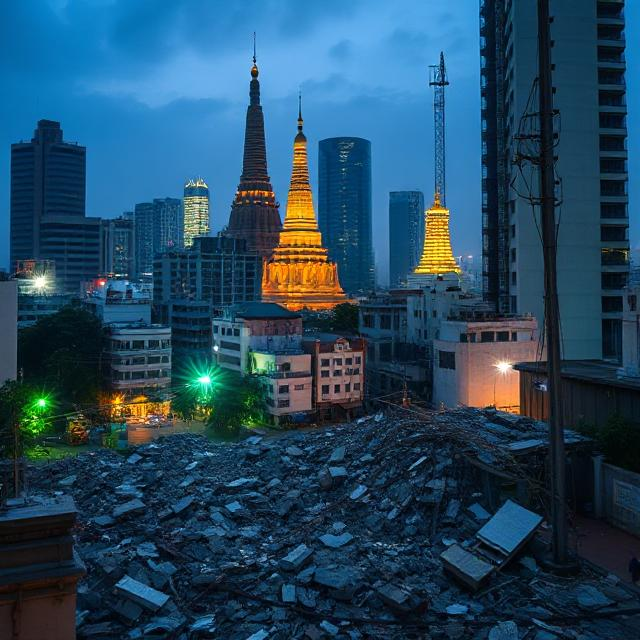
A Comprehensive Guide to Bangkok’s High-Rise Construction Safety Measures Post-2025 Earthquake
In 2025, a 7.7-magnitude earthquake originating in Myanmar’s Sagaing Fault shook Bangkok, exposing critical vulnerabilities in its high-rise infrastructure. The collapse of a 33-story State Audit Office (SAO) building under construction, which claimed at least 92 lives, underscored the urgent need for enhanced seismic safety measures in Thailand’s capital, home to over 5,994 high-rise buildings. This guide explores Bangkok’s response, including updated building codes, advanced engineering solutions, community engagement, and challenges, offering a roadmap for a resilient urban future.
Drawing lessons from global leaders like Japan and California, Bangkok’s efforts focus on balancing safety, innovation, and economic feasibility. This comprehensive overview provides actionable insights for residents, developers, and policymakers navigating seismic risks in 2025’s dynamic urban landscape.
The 2025 Earthquake’s Wake-Up Call
The March 28, 2025, earthquake, centered 1,000 km away in Myanmar, was amplified by Bangkok’s soft, alluvial soil, leading to widespread structural concerns. The SAO building’s collapse, attributed to substandard steel from a Chinese supplier and a poorly designed off-center concrete core, highlighted deficiencies in construction practices. Over 14,430 cases of damage, including cracked walls and buckled floors, were reported across the city, particularly in governmental buildings.
Immediate responses included seismic assessments, evacuations, and temporary lodging for affected residents. The Bangkok Metropolitan Administration (BMA) collaborated with engineering firms to review structural integrity, prompting a citywide push for reform to prevent future disasters.
Revamping Building Codes
Thailand’s seismic building codes, updated in 2007 and 2021, require structures over 15 meters to withstand magnitude 7.0 quakes. Post-2025, Bangkok is strengthening these regulations to align with global standards, mandating high-quality materials and rigorous compliance. Neutral engineering teams are conducting inspections, focusing on buildings constructed before 2007, which lack robust seismic provisions.
The BMA is enforcing third-party evaluations and prioritizing transparency to ensure new high-rises meet stringent safety criteria, addressing past oversights exposed by the SAO collapse.
Embracing Advanced Engineering
Bangkok is adopting state-of-the-art engineering solutions to enhance seismic resilience. Base isolation systems, which absorb earthquake shocks, and flexible, high-strength materials are becoming standard. Performance-Based Design (PBD) is used to validate buildings under higher seismic forces, minimizing costly retrofits while ensuring safety.
Reinforced concrete cores and deep foundations tailored to Bangkok’s soft soil are now mandatory for new constructions, reducing risks of structural failure during seismic events.
Retrofitting Vulnerable Structures
Buildings constructed before 2007, under less stringent codes, are at high risk. Bangkok is implementing retrofitting programs guided by standards like ASCE 41-13 and Thailand’s DPT 1303-57. Rapid Visual Screening identifies vulnerable structures, followed by detailed seismic evaluations to strengthen columns, beams, and foundations.
Volunteer engineers are inspecting older buildings no longer under developer warranties, ensuring they meet updated standards to protect occupants during future quakes.
Empowering Communities Through Preparedness
The 2025 quake exposed weaknesses in Bangkok’s emergency alert system, which could only reach 200,000 people at once. The Department of Disaster Prevention and Mitigation is now enhancing public training programs, offering evacuation drills and safety workshops to build community resilience. Improved emergency communication channels are also being developed.
Community apps like ThaiQuake Alert and SafeEarth provide real-time updates, fostering trust and ensuring residents are informed and prepared for seismic events.
Leveraging Technology for Safety
Technological advancements are transforming Bangkok’s earthquake response. Early warning systems, inspired by Japan’s models, are being deployed to deliver timely alerts. Drones and thermal imaging, used effectively in the SAO rescue efforts, enhance response efficiency. Real-time structural health monitoring systems detect stress or cracks, enabling proactive maintenance.
These innovations minimize disruption and improve safety, positioning Bangkok as a leader in urban seismic preparedness.
Learning from Global Seismic Leaders
Bangkok is adopting best practices from Japan, known for its base isolators and dampers, and California, with its robust regulatory framework and community education programs. These models are tailored to Bangkok’s unique soil conditions and dense urban landscape, ensuring effective seismic resilience strategies.
By studying global successes, Bangkok is refining its approach to building codes and disaster preparedness, creating a blueprint for other vulnerable cities.
Addressing Financial and Regulatory Hurdles
Upgrading building standards and retrofitting older structures involve significant costs, challenging developers and property owners. Pre-2007 lax enforcement and substandard practices, as seen in the SAO case, complicate compliance. The Thai government is exploring subsidies, tax incentives, and long-term insurance policies to ease financial burdens.
New constructions now include a 2-year component guarantee and a 5-year building fabric warranty, ensuring accountability and encouraging investment in seismic safety.
Rebuilding Trust and Economic Stability
The 2025 earthquake damaged Bangkok’s tourism image, with global coverage of the SAO collapse impacting condo sales. Residents’ fears have shifted demand toward low-rise housing, echoing trends post-2011 floods. The Thai Condominium Association is promoting modern high-rises’ resilience, highlighting their ability to withstand the quake.
Financial aid programs and seismic certification campaigns are restoring public confidence, ensuring Bangkok remains an attractive hub for residents and investors.
Shaping a Resilient Urban Future
Bangkok’s proactive measures—strengthened codes, advanced engineering, and community engagement—set a global standard for urban seismic resilience. By addressing challenges like cost and compliance, the city is building a safer skyline. These efforts demonstrate a commitment to protecting lives and property in an era of increasing natural disasters.
As Bangkok continues this transformation, it serves as a model for cities worldwide, proving that thoughtful urban planning can mitigate the impacts of unpredictable seismic events.
In 2025, Bangkok’s response to the March earthquake marks a turning point in urban resilience. By integrating advanced engineering, robust building codes, and community preparedness, the city is forging a safer future. This comprehensive approach not only protects Bangkok’s skyline but also inspires global cities facing similar seismic challenges, ensuring thriving urban environments for generations to come.






